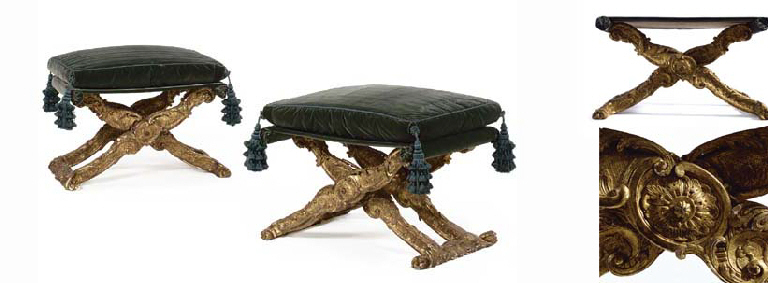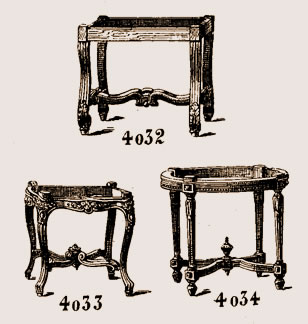TABOURET
tab·ou·ret [tab-er-it, tab-uh-ret, -rey]
noun [tab-er-it, tab-uh-ret, -rey]
noun [tab-er-it, tab-uh-ret, -rey]
1. a low seat without back or arms, for one person; stool.
2. a frame for embroidery.
3. a small, usually portable stand, cabinet, or chest of drawers, as for holding work supplies.
4. a small tabor.
Origin:
mid 17th century < French tabouret literally, small drum, from Middle French, diminutive of tabor, tabour drum, from Old French.
mid 17th century < French tabouret literally, small drum, from Middle French, diminutive of tabor, tabour drum, from Old French.
The French word tabouret refers to an upholstered footstool or bench.
 |
| Louis XIV Tabourets with Tassels and Lavish Carvings. From the Collection of Jacques Doucet, 1912. |
The history of stools in Europe can be traced back to the late 1500's. During the reign of King Louis XIV, when chairs were status symbols and no ordinary person could aspire to own one, a hierarchical seating system featured a fauteuil (an armchair) for the king and queen to sit upon. One did not just take a seat when the King or Queen was present. This was dictated by etiquette.
 |
| Tabouret and Fauteuil in Louis XIV Style |
No one else was allowed an armchair in their presence, except for another monarch visiting the French court. He or she would be offered an armchair as well. A chair with a back but no arms was considered appropriate for those closest in rank to the king, such as his brother, sister or children, and a tabouret was provided only for the more privileged ladies of the court to sit upon in the royal presence. Everyone else was required to stand, no matter their age or fortune.
 |
The court tabouret was an elaborate, upholstered stool with curved wooden legs and tassels, carried by a liveried and wigged servant. It was a much desired honor to sit in the presence of the royal family and a lady’s rank determined how lavishly her tabouret was decorated. A duchess was automatically granted the honor of sitting in front of the queen.
 | ||||
| Pair of Louis XV Tabourets. Circa 1735-1740. Realized $216,000 at Christie's Auction. |
 |
| Fig. 4032. Tabouret Loius XIII. Prix, en noyer ciré : 20 francs. Fig. 4033. Tabouret Louis XIV. Prix, en noyer ciré : 25 francs. Fig. 4034. Tabouret Louis XVI. Prix, en noyer ciré : 20 francs. From Le Dictionnaire Pratique de Menuiserie - Ebénisterie - Charpente By J. Justin Stoeck, 1900 |
Tabourets
of various designs later became fashionable as household furniture,
particularly in France and England.
 |
| Louis XVI Needlepoint Tabouret |
 |
| Louis XIII Style Tabouret |
 |
| Louis XIII Tabouret |
 |
| Henri II Tabouret. Circa 1890. Leather Seat with Nailhead Trim. |
 |
| Country French Tabourets with Rush Seats |
 |
| Louis XIII Os de Mouton Tabouret |
 |
| Louis XIII Barley Twist Tabouret |
 |
| Modern Tabouret with Acrylic Legs and Natural Hide Seat |
Remember, next time you "take a seat" on what you thought was just an ordinary stool, you're sitting pretty...like royalty.
But Lolo, he gets the back and the arms...a seat fit for a king!
Á Bientôt!
Lolo & Mimi



No comments:
Post a Comment